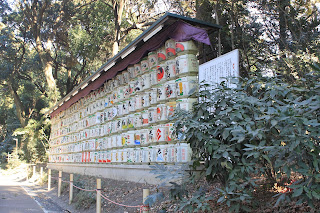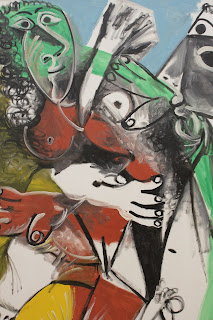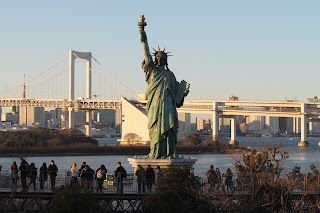I finally made it to Tokyo for the first time ever this year in January. It was always very high on my list, but I had somehow never managed to visit. My father had spent 3 years in Tokyo in the late 1950s; he learned Japanese as his foreign language when he joined the Indian Foreign Service, and Tokyo was his first ever posting as a diplomat. He used to often talk about his time in Tokyo, so I was really looking forward to my visit, though it was with a tinge of sadness, because I didn't make it there in his lifetime!
Tokyo has a population of almost 9 million; it goes up to over 13 million if one takes Tokyo Prefecture; if one takes Greater Tokyo (which includes suburbs like Yokohama and Kawasaki), the population is a staggering 37 million, making it the largest urban agglomeration in the world! Tokyo, earlier called Edo, has been the capital of Japan since 1868, when Emperor Meiji shifted the capital from Kyoto. It's quite amazing how tradition, history and the glitzy modern world all co-exist beautifully in this city.
I had hear about Tokyo being one of the world's most expensive cities. I was pleasantly surprised to note that that was not my experience at all. Sure, if one wants to spend money by staying in fancy hotels, eating at fine dining restaurants, and travelling everywhere by taxi, then Tokyo can be very expensive. But if one is a little careful, Tokyo is unbelievably reasonable. It's about 110 JPY to 1 US Dollar. My daily spends, barring my hotel stay, came to barely 5,000 JPY, and that included my lunch and dinner (my average meal cost me not more than 1,000 JPY), travelling to every nook and corner of the city by metro, and a lot of sightseeing (most museums, shrines and other places of interest had entrance fees of barely 500 JPY). My hotel, which was a fairly comfortable three star property not far from the heart of the city, cost me around 8,000 JPY a night, including breakfast, so that was pretty reasonable too.
For a traveler, Tokyo has a lot to offer. I'd be out of my hotel by around 8 am, and I'd be back by around 6 pm, having packed in 4 or 5 sites every day. I ended up walking over 20 km a day, but that does happen when one is going everywhere by public transport. It was winter, with temperature ranging between 5 and 10 degrees Celsius, so after being clad properly, walking so much was hardly a problem (it's that much tougher in summer when one tends to sweat like crazy).
 |
Panoramic view of Tokyo, with Mount Fuji
in the background, as seen from Tokyo Skytree |
Senso-ji Temple is Tokyo's best known temple. The temple's origins date back to the 7th century AD. One enters from the Kaminarimon Gate and walks through Nakamise-Dori, a 250 meter long street with traditional shops on both sides. Besides the Main Hall with the main deity, the temple also has a large 5 story pagoda.
 |
| Senso-ji Temple, with its 5 story pagoda |
 |
| Hozoman Gate, Senso-ji Temple |
 |
| Kaminarimon Gate, Senso-ji Temple |
 |
| Main Hall, Senso-ji Temple |
 |
| Nade Botokesan Buddha, Senso-ji Temple |
Meiji Shrine lies in the middle of a large forested area, and is dedicated to Emperor Meiji and Empress Shoken. The emperor died in 1912, and was one of the most popular emperors in the country's history. To get to the main shrine, one has to walk a lot through the forested area, and one also walks through a few large gateways.
 |
| Meiji Shrine |
 |
| First Gateway, Meiji Shrine |
 |
| Sakes, Meiji Shrine |
Yasukuni Shrine is a Shinto shrine established by Emperor Meiji in 1869. It
commemorates Japanese soldiers who died in various wars. The complex has an
interesting war museum, and lists details of over 2 million people killed in
battle.
 |
Omura Masujiro statue at
Yasukuni Shrine |
The Imperial
Palace is the residence of
the Emperor of Japan. The complex lies within large gardens, and includes the
main palace, the royal residences, an archive, museums and offices. Edo Castle
was previously situated at this site.
 |
| The Imperial Palace seen from Nijubashi Bridge |
The National
Diet Building is where the
Japanese parliament sits. The building was completed in 1938. The central tower
, with its pyramid shaped dome, is 65 meters high, and at the time of its
construction, it was the tallest building in Tokyo.
 |
| National Diet Building |
Tokyo Skytree is a transmission and observation tower. It was completed in 2012. and at a height of 634 meters, it became the world's second tallest structure, after Dubai's Burj Khalifa, which has a height of 829 meters. Tokyo Skytree offers great views of Tokyo, and on clear days, Mount Fuji (which is 100 km away) is also visible.
 |
| Tokyo Skytree |
Tokyo Tower was built in 1958. It has a height of 333 meters and is orange and white in colour. It was inspired by Paris' Eiffel Tower, and is even taller than it. Though much shorter than Tokyo Skytree, Tokyo Tower also has splendid views of the city.
 |
| Tokyo Tower |
Shinjuku is a large commercial district. Shinjuku East is known for its
red light district, entertainment zones and bars. Shinjuku West boasts of
skyscrapers like the Tokyo Metropolitan Government Building, the Monolith
Building and the Sonpo Japan Building. Another famous district in Tokyo is Shibuya, a shopping and commercial district surrounding Shibuya Station. It’s a popular
hang-out district with the youth, and is full of shops and restaurants catering
to them.
 |
| Sonpo Japan Building, Shinjuku West |
 |
| Sculpture at Tokyo Metropolitan Assembly, Shinjuku West |
 |
| Tokyo Metropolitan Assembly, Shinjuku West |
Ginza is an upmarket shopping district in the heart of Tokyo,
and is known for its department stores, and its luxury shops. Highlights at Ginza include Mitsukoshi Department Store, Wako Department Store with its distinctive clock-tower, Kabuki-za
Theatre, and stores of high end brands like Louis Vuitton, Chanel and Dior.
 |
| Kabuki-za Theatre at Ginza |
 |
| Wako Department Store at Ginza |
 |
| San'ai Building at Ginza |
Ueno Park is
a large urban park that opened in 1873.
The park has several prominent museums including Tokyo National Museum,
National Museum of Western Art and National Museum of Nature and Science. It
also features Ueno Zoo, Japan’s oldest zoo which opened in 1882.
 |
| Saigo Takamori Statue, Ueno Park |
 |
| Pagoda, Ueno Zoo |
 |
| Polar Bear, Ueno Zoo |
 |
| Tiger, Ueno Zoo |
Tokyo National Museum was established in 1882. The complex consists of the Honkan Gallery (the
Japanese Gallery), the Toyokan Gallery (the Asian
Gallery) and the Heiseikan Gallery (which boasts of a fine collection of
archaeological finds). The museum has over 110,000 objects, and is one of the
largest art museums in the world.
 |
Head of a Man at the Honkan Gallery,
Tokyo National Museum |
 |
Buddha Triad from China at the Toyokan Gallery,
Tokyo National Museum |
 |
Terracotta Horse at the Heiseikan Gallery,
Tokyo National Museum |
 |
Korean Daggers at the Toyokan Gallery,
Tokyo National Museum |
 |
Papier Mache Dog at the Honkan Gallery,
Tokyo National Museum |
 |
Glazed Camel at the Toyokan Gallery,
Tokyo National Museum |
National Museum of Western Art has an impressive collection of
European paintings and sculptures by artists like Rubens, Monet, Rodin, Cezanne
and Picasso. The museum was set up in 1959, and primarily has the private
collection of Matsukata Kojiro (1865-1960). The
building was designed by the famous French architect Le Corbusier.
It has by far the most amazing collection of European art that I have seen outside Europe and the US.
 |
Renoir's Reclining Bather,
National Museum of Western Art |
 |
Monet's Peony Garden,
National Museum of Western Art |
 |
Rubens' Two Sleeping Children,
National Museum of Western Art |
 |
Rodin's The Thinker,
National Museum of Western Art |
 |
Monet's Water Lillies,
National Museum of Western Art |
 |
Picasso's Couple,
National Museum of Western Art |
 |
Segantini's The Sheepshearing,
National Museum of Western Art |
 |
Sisley's The Port of St Tropez,
National Museum of Western Art |
The National
Museum of Nature and Science has an impressive collection of dinosaur skeletons,
stuffed animals, models of ancient man, minerals, telescopes, clocks and
scientific equipment.
 |
| Dinosaur skeleton at National Museum of Nature and Science |
 |
| Exhibit on Dogs at National Museum of Nature and Science |
Tokyo International Forum is a multi purpose exhibition centre. The steel and glass structure was completed
in 1996. It has an exhibition hall, restaurants, shops. The building is shaped
like an elongated boat.
 |
| Tokyo International Forum |
 |
| Royal Costume, Tokyo International Forum |
Madame Tussauds lies in Odaiba,
across the Rainbow Bridge. It is inside Decks Mall along the waterfront, and
has wax figures of Japanese and international celebrities. It is one of some 2 dozen Madame Tussauds museums that have now sprung up across the world.
 |
Wax sculpture of former Japanese Prime
Minister, Junichiro Koizumi, at Madame Tussauds |
 |
Wax sculptures of Madonna
at Madame Tussauds |
 |
| Michael Jackson at Madame Tussauds |
There is a Statue
of Liberty replica at Odaiba, close to the Rainbow
Bridge, and near the Decks Mall that houses Madame Tussauds. It is a symbol of Japanese - American friendship.
 |
| Statue of Liberty replica |
Tokyo Station is
the city's main railway station, with trains going all over Japan from there.
Japan is famous for its Shinkansen Bullet Trains,
that touch speeds of close to 300 kmph, are known for their efficiency and
precision, and are a life-line in the country.
 |
| Tokyo Station |
 |
| Shinkansen, Tokyo Station |
Mount Fuji lies 100 km south
west of Tokyo, and on clear days, can be seen from places like Tokyo Skytree and Tokyo Tower. The
peak is Japan’s highest and stands at a height of 3,776 meters. It is an active
volcano that last erupted in 1708.
I went on a full day's guided bus tour to Mount Fuji, and the tour included visits to several places at the base of the peak - Oshino Eight Ponds (where melted snow from the peak trickles and settles down over a period of many years), the Japanese Garden at Oshino Ninja Village, Fujiyama Amusement Park (with its spectacular 4D virtual reality experience of flying over Mount Fuji) and Lake Kawagachiko. It was an awesome day, but the dampener was that it was cloudy, and I couldn't get a very clear view of the peak.
 |
| Mount Fuji |
Japanese cuisines are famous all over the world. The best known Japanese cuisines are probably Sushi (usually cold seafood) and Ramen (hot soup with noodles and meat). Both are widely available and are popular with locals and tourists.
 |
| Ramen with Fried Chicken, a local speciality |
All in all, Tokyo was an amazing experience. I managed 5 action packed days between Tokyo and Mount Fuji, and managed to cover the main highlights. I missed out on the world famous Tsukiji Fish Market (the world's largest fish market) because it was shut the day I visited. If I had another day, I would have also visited Tokyo Disneyland, but I only had so much time. The friendliness and politeness levels of the Japanese people were simply amazing. I was also awestruck by the overall efficiency and precision levels everywhere, and nowhere was this more true than in the amazing Shinkansen bullet trains (which I experienced on my trip to Kyoto), where a time of 9:18 means 9:18 and not even 9:18 and 30 seconds! Quite a contrast from the Indian Standard Time that I normally see around me, where 5 minutes can range from 5 minutes to half an hour!!


















































No comments:
Post a Comment